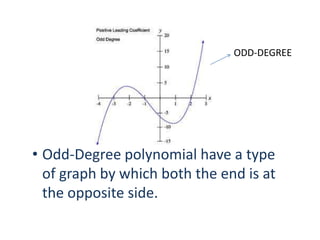Advanced functions part ii
- 1. Advanced Functions Prepared by: E-Presentation Tan Yu Hang Tai Tzu Ying Part II Wendy Victoria Vaz Tan Hong Yee Voon Khai Sam Wei Xin
- 2. 1.3 Equations and Graphs of Polynomials
- 3. Definitions • interval of increase: an interval over the domain of a function where the value of the function is strictly increasing (going from left to right). • interval of decrease: an interval over the domain of a function where the value of the function is strictly decreasing (going from left to right). • odd function: all odd functions have rotational symmetry about the origin and satisfy the equation f (−x) = − f (x) . • even function: all even functions have symmetry about the y-axis and satisfy the equation f (−x) = f (x) .
- 4. Example 0 x 2 x 3 x 1 x 5 • x and y intercepts would be useful and we know how to find those. To find the y intercept we put 0 in for x. 3 2 f 0 04 30 15 0 19 0 30 30 • To find the x intercept we put 0 in for y. • Finally we need a smooth curve through the intercepts that has the correct left and right hand behavior. To pass through these points, it will have 3 turns (one less than the degree so that’s okay)
- 5. Example 0 x 2 x 3 x 1 x 5 • We found the x intercept by putting 0 in for f(x) or y (they are the same thing remember). So we call the x intercepts the zeros of the polynomial since it is where it = 0. These are also called the roots of the polynomial. • Can you find the zeros of the polynomial? 3 2 g ( x) x 1 x 2 x 3 • There are repeated factors. (x-1) is to the 3rd power so it is repeated 3 times. If we set this equal to zero and solve we get 1. We then say that 1 is a zero of multiplicity 3 (since it showed up as a factor 3 times). • What are the other zeros and their multiplicities? -2 is a zero of multiplicity 2 3 is a zero of multiplicity 1
- 6. So knowing the zeros of a polynomial we can plot them on the graph. If we know the multiplicity of the zero, it tells us whether the graph crosses the x axis at this point (odd multiplicities CROSS) or whether it just touches the axis and turns and heads back the other way (even multiplicities TOUCH). Let’s try to graph: 2 f x x 1 x 2 What would the left and right hand behavior be? You don’t need to multiply this out but figure out what the highest power on an x would be if multiplied out. In this case it would be an x3. Notice the negative out in front.
- 7. Steps for Graphing a Polynomial • Determine left and right hand behavior by looking at the highest power on x and the sign of that term. • Determine maximum number of turning points in graph by subtracting 1 from the degree. • Find and plot y intercept by putting 0 in for x • Find the zeros (x intercepts) by setting polynomial = 0 and solving. • Determine multiplicity of zeros • Join the points together in a smooth curve touching or crossing zeros depending on multiplicity and using left and right hand behavior as a guide.
- 8. Let’s graph f x x2 x 3 x 4 Join the points together in a smooth curve touching or crossing zeros depending on multiplicity and using left and right hand behavior as a guide. Here is the actual graph. We did pretty good. If we’d wanted to be more accurate on how low to go before turning we could have plugged in an x value somewhere between the zeros and found the y value. We are not going to be picky about this though since there is a great method in calculus for finding these maximum and minimum.
- 9. 1. Degree of the polynomial function 2. Sign of leading coefficient 3. End Behavior 4. X and Y intercepts 5. Intervals
- 10. 1.Degree of the polynomial function EVEN-DEGREE • This is a EVEN root polynomial function. • Even-degree polynomials are either facing up or down on both ends.
- 11. ODD-DEGREE • Odd-Degree polynomial have a type of graph by which both the end is at the opposite side.
- 12. POSITIVE COEFFICIENT NEGATIVE COEFFICIENT
- 13. 3.End Behavior • Can be determined through the end of the by which it extended from quadrant _ to quadrant _ Quadrant 2 Quadrant 1 Quadrant 3 Quadrant 4
- 14. 4. X and Y intercepts • If a polynomial function has a factor (x-a) that is repeated n times, then x=a is a zero of order. Example: •(x-2)2=0 has a zero of order 2 at x=2.
- 15. 5.Intervals For Example: Y=(X+1)1(X-1) interval X<1 -1<X<1 X>1 Sign of Choose a Choose a Choose a leading number number number coefficient which is between -1 which is smaller/les and +1. bigger/m ser than -1 then do the ore than 1 and sub same thing and into the again as substitute equation. you did it it into the Then one the polynomi determine previous al whether it column. equation. is +/-
- 16. The End. Ho p e y o u e n j o y e d o u r Ad v a n c e d Func t i ons E- Pr e s e nt a t i on a nd l e a r nt s o me t h i n g !
















